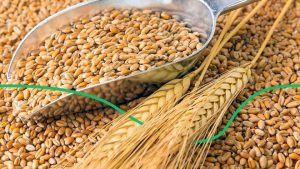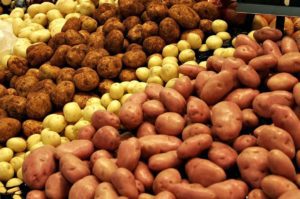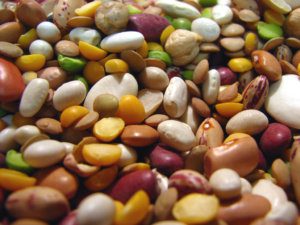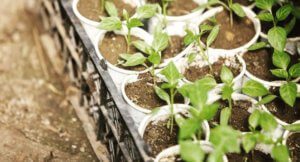
As of November 2, Ukrainian agricultural producers harvested 70.5 million tonnes of basic crops from an area of 21.8 million hectares, in particular, 53.5 million tonnes of grain and leguminous crops were harvested from an area of about 13.5 million hectares (88% of the forecast).
According to a report posted on the website of the Ministry of Economic Development, Trade and Agriculture, the following crops were collected: corn – 17.6 million tonnes from an area of 3.6 million hectares (66%), sunflower – 12.1 million tonnes from 6.1 million hectares (95%), soybeans – 2.4 million tonnes from 1.2 million hectares (88%), millet – 240,400 tonnes from 147,800 hectares (98%) and buckwheat – 100,300 tonnes from 77,700 hectares (99%).
Some 5.1 million tonnes of sugar beet were dug out from an area of 124,000 hectares (57%).

As of May 28, Ukrainian farmers planted 14.9 million hectares of spring crops, which is 96% of the forecast (15.5 million hectares), Minister of Development of Economy, Trade and Agriculture Taras Vysotsky wrote on his Facebook page last week.
According to him, over the past week, the area with crops in the regions expanded by 275,000 hectares.
Thus, the areas with the main crops as of May 28 were the following: sunflower – 5.99 million ha; corn – 5.33 million ha; barley – 1.52 million ha; soybeans – 1.34 million ha, peas – 282,710 ha, sugar beets – 209,010 ha; spring wheat – 184,530 ha; peas – 282,710 ha; oats – 186,350 ha, buckwheat – 55,230 ha.
As reported, the sown area of major crops in 2020 will increase by 600,000 hectares compared with 2019 and will amount to 15.5 million hectares. In the structure of crops of the spring group, it is predicted that the proportion of corn and sunflower will increase, and that of barley, soy and sugar beets will decrease.
The Ministry for Development of Economy, Trade and Agriculture predicted that farmers will harvest 65-68 million tonnes of grain crops in 2020, compared to 75 million tonnes in 2019.

The CFG/Mriya combined company has completed planting potatoes on an area of 2,000 ha in Ternopil and Lviv regions, plans to expand the areas with potatoes by 300-500 ha every year next two seasons.
According to a company report, CFG/Mriya also plans to buy equipment for modernization of potato storage facilities this year.
“Before the consolidation of CFG and MRIYA both companies successfully cultivated potatoes for a long time… both for food and for seed varieties. Therefore, for the combined CFG/MRIYA Company the growing of potato remains a strategic direction,” the company said.
CFG/Mriya has potato storage facilities with a capacity of above 87,000 tonnes, and a starch factory.
As reported, SALIC UK Ltd, the common investor in the merged business CFG/Mriya, plans to send over $50 million for boosting technical fleet in 2019.

Areas with sugar beets in Ukraine as of March 26, 2019 reached 20,000 ha, or 10% of the projections, the press service of the Ukrtsukor national association of sugar producers has reported.
According to the association, 11,000 ha were sowed with beets in Khmelnytsky region, 3,500 ha in Rivne, 2,700 ha in Volyn and 2,400 ha in Ternopil regions.
The association said that early sowing on 10% of the areas is thanks to the low soil moisture after winter, most beet growers plan to start sowing in the first decade of April.
As reported, Ukrtsukor predicts a reduction in the areas with sugar beet by 20%, to 220,000-230,000 hectares due to low prices in the past two years against the backdrop of a global sugar surplus. Sugar production in the 2019/2020 agricultural year (September-August) is projected at 1.5-1.6 million tonnes (in 2018/2019 agri-year 1.82 million tonnes).
Ukraine in the first half of 2018/2019 agri-year exported 274,400 tonnes of sugar, which is 6% less than in the previous season.

Areas planted with leguminous crops in 2018 were expanded by 12.4% compared with the previous year, to 568,400 ha, while their harvest fell by 15.9%, to 1.04 million, according to the UkrAgroConsult analytical agency. “Despite the decline in prices and profitability, the area planted with legumes actually increased this year. At the same time, there was a decrease in yield, but the weather factor worked here. One can argue how negative the weather factor is, which affected the decrease in yield, decrease in supply, but it is quite possible it contributed to the prices. The conclusion we are making is that farmers continue to trust legumes,” Director General of the UkrAgroConsult analytical agency Serhiy Feofilov said at a conference in Kyiv.
He said that the export of legumes will be high this season.
“This year, the export of peas will fall quite strongly. Earlier, in the structure of exports from Ukraine, chickpeas dominated, now horse beans and beans, and lentils have recently sold well. According to the nuances of logistics, if two or four years ago up to 90% legumes were exported from Ukraine by containers, but now the situation has changed and up to 60% is exported in bulk and mainly this is export of peas,” Feofilov said.
According to him, in the outlook of three to five years, the drivers of the development of the legume market of the Black Sea region will be: stable growth in demand, the need to restore crop rotation after oversaturation with oilseed crops, attractiveness both for large farms (peas, large batches) and for small farms (other legumes), differentiation of the commodity nomenclature for farms, new trends in healthy nutrition from the use of legumes.
According to Ukraine’s Agricultural Policy and Food Ministry, global demand for legumes is growing faster than supply. Today, the largest producers of legumes in the world are India, China and Canada.
“Ukraine has all the prerequisites to become one of the key producers of these products and a supplier of legumes to the global market,” Deputy Minister of Agrarian Policy and Food on European Integration Olha Trofimtseva said.
According to her, Ukrainian exports of legumes are growing significantly. The main buyers of Ukrainian products are India, Turkey, Pakistan, Myanmar and the Netherlands.
“In 2015, we exported legumes to the amount of $60.6 million, in 2017 – $148.5 million, and for the results of January-October, this figure is $97.7 million,” the deputy minister said.

The total area of farmland having the status of organic land expanded by10.2% in 2017 from a year ago, reaching 420,000 ha (1% of total farmland in Ukraine). According to information posted on the website of the Agricultural Policy and Food Ministry, in the past five years the total area of organic farmland in Ukraine expanded 1.5-fold.
By the total area of farmland certified as organic, Ukraine ranks 11th in Europe and 20th in the world. At the same time, almost half of the land is under grain cultivation (45.4%), more than 18% are oilseeds and 5.3% are legumes, followed by vegetables (1.6%) and fruits (0.7%). Most of the organic lands are located in Kyiv, Odesa, Kherson, Zhytomyr, Lviv, Khmelnytsky, Vinnytsia and Poltava regions. In 2017, the consumer market of organic products in Ukraine amounted to EUR 29.4 million, and per capita consumption was EUR 0.68 per year (for comparison, the EU resident spends EUR 60.5 per year on organic products).
The main types of organic products that are produced and consumed in Ukraine are fruits, vegetables, cereals, meat and dairy products, cereals and bakery products. The range of organic products includes more than 100 products of Ukrainian origin.
According to the Reform Support Team under the ministry, in 2017, in Ukraine there were 529 organic market operators. The volume of exports of organic products in 2017 increased by 10%, 330,000 tonnes and amounted to EUR 99 million. About 98% of exported products are raw materials. The largest consumer countries of the Ukrainian organic goods are: the Netherlands, Germany, the U.K., Italy, Austria, Poland, Switzerland and Belgium. The main export products are cereals, oilseeds, legumes, berries, fruits and wild plants.